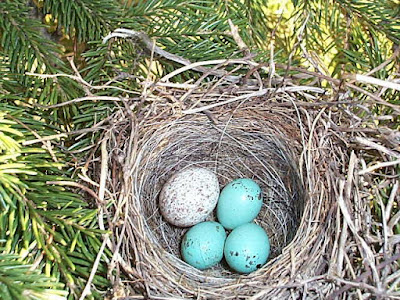Early days
It seems like no time before the eggs are hatched, three in this case.
All three have hatched
Both parents participate in the feeding and caring for the young and as the nest is almost on a level with our bedroom window we can easily watch these diligent parents go about their daily routines. When the chicks are young one parent usually sits on them keeping them warm while the other brings food; seamless shift changes take place in the blink of an eye as one parent relieves the other allowing it to obtain food for itself.
Robins are model parents of the bird world, from providing a substantial home to nurturing and feeding the nestlings and the continued feeding and protection of the fledglings as they hop around our lawns or sit in the shrubs awaiting their next meal. A particularly hazardous time for the fledgling with its very limited ability to get off the ground leaving it very vulnerable to predators the worst of which is the neighbourhood cats. Not all birds take parenting so seriously, in fact some like our Brown-headed cowbird take a particularly modern attitude and out-source the whole business. They are one of several species that are parasitic choosing to lay their egg in another species nest leaving the responsibility for hatching, feeding etc to the host bird leaving the Cowbird free to get on with its life. They usually choose a smaller species as host in this instance the nest of a Chipping sparrow and although the usurper's egg is quite different it is accepted by the sparrow.
The Chipping sparrow is one of the smallest sparrows we have and the Cowbird is a similar size to a Redwing blackbird so the sparrow is going to have its work cut out for it and sadly the sparrow's own brood is doomed. Before long we have four chicks in the nest that have to be fed. As you can see below there is little doubt as to who will get the lion's share of the food and the Cowbird chick will quickly outgrow its adopted family. Eventually it will push it's siblings from the nest to perish, leaving it the sole survivor and ward of the harassed Chipping sparrow whose every minute will be devoted to the care of this giant.













